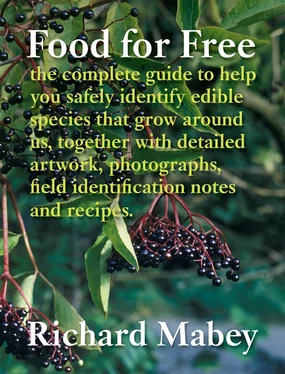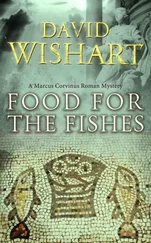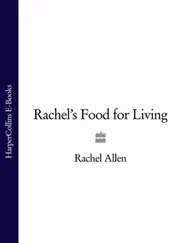For myself, I’m not overly worried about the conservation impact of foraging. Almost all orthodox wild foods – leaves, nuts, fruits, even mushrooms – are a renewable resource, and are shed naturally by plants. And the impact of picking on wild vegetation is negligible when you compare it with the destructive effects of modern agriculture. But foraging has other, more subtle, side effects. It competes with the food gathering of wild birds and mammals. In some places it can make a visible impression on the local landscape, and spoil the enjoyment of walkers and naturalists. What we need more than legislation, I believe, is a foraging etiquette, to regulate our gathering enthusiasms in keeping with the needs of other organisms in the ecosystem (non-foraging humans included).
Paradoxically, it may be the restaurants that are doing most to develop this. The new wild food recipes use minute quantities of their ingredients. The ways in which they are cooked – frosted, blanched, quick-pickled, for instance – are designed to bring out the intensity of flavour, that ‘bitter sweet’ of the gathered wilding that Thoreau rhapsodised over. And chefs like René Redzepi are conjuring whole miniature ecosystems in their dishes. One of Noma’s set-pieces is ‘Blueberries surrounded by their natural environment’, an extraordinary evocation of an autumn heathland, with balls of spruce and bilberry ice-creams nestling in a cooled salad of wood sorrel and heather tops. It might be overstating things to call dishes like this works of art. But they have the same intentions as art, to encourage us to experience and think about the astonishing variety and texture of the wild, not to satisfy our hunger. And so they are able to employ the smallest quantities of their foraged ingredients.
I find I’ve drifted this way myself, evolving into a wayside nibbler. I like lucky finds, small wayside gourmet treats. I relish the shock of the new taste, that first bite of an unfamiliar fruit. Sun-dried English prunes, from a damson bush strimmed while it was in fruit. Single wild blackcurrants picked from a boat. Reed-stems, sucked for their sugary sap. Often the catch is apples, wayside wildings sprung from thrown-away cores and bird droppings. They seem to catch everything that’s exhilarating about foraging: a sharpness of taste, and of spirit; an echo of the vast, and mostly lost, genetic diversity of cultivated fruits; a sense of place and season. I’ve found apples that tasted of pears, fizzed like sherbet, smelt of quince, and still dream of discovering the lost Reinette Grise de St. Ogne with its legendary fennel savour. But it’s the finding of them, the intimacy with the trees and the places they grow, a heightened consciousness of what they need to survive, that are just as important. And it’s maybe that growing sense of intimacy amongst the new foragers that will provide the feedback to conserve their resource: ‘if you don’t take care of it you lose it.’ For me, it has generated the rough ethic, or etiquette, of scavenging. For preference I work the margins now, look for windfalls, vegetable road-kills, sudden flushes, leftovers. Or just those small, serendipitous treats off the bush. The 1930s fruit gourmet Edward Bunyan, meandering through his gooseberry patch, described the pleasures of ‘ambulant consumption’: ‘The freedom of the bush should be given to all visitors’. The freedom of the bush: it’s a liberty we should all enjoy, but also treasure.
This 40th anniversary edition includes many new recipes, including some based on ideas from René Redzepi, Sam and Sam Moro, and my old friend and fellow-forager Duncan Mackay. But I have not tinkered with the core of the text, despite its youthful and sometimes naïve idealism. That, after all, is what sparked the book off. If there are moments of, shall we say, tastelessness as a result, then the responsibility is entirely mine.
Richard Mabey, Norfolk 2012
© Nicholas and Sherry Lu Aldridge/FLPA
Introduction
It is easy to forget, as one stands before the modern supermarket shelf, that every single one of the world’s vegetable foods was once a wild plant. What we buy and eat today is still essentially nothing more special than the results of generations of plant-breeding experiments. For most of human history these were directed towards improving size and cropping ability. Some were concerned with flavour and texture – but these are fickle qualities, dependent for their popularity as much on fashion as on any inherent virtue. In later years there have been more ominous moves towards improving colour and shape, and most recently we have seen developments such as genetically modified crop plants and irradiated food, raising worries not only about human health but also about the potentially harmful effects of modern farming methods on the environment.
Indeed, concerns over modern methods of food production have led to something of a backlash, and Michelin-starred chefs are advocating the joys of marsh samphire, a native coastal plant that goes beautifully with another native wild food, fish. For the rest of us likewise: if plant breeding has been directed towards the introduction of bland, inoffensive flavours, and has sacrificed much for the sake of convenience, those old robust tastes, the curly roots and fiddlesome leaves, are still there for the enjoyment of those who care to seek them out.
To some extent, we have become conditioned by the shrink-wrapped, perfectly shaped produce we find in our supermarkets, and we are reluctant to venture into woods, pastures, cliff-tops and marshlands in search of food. But in fact almost every British garden vegetable (greenhouse species excepted) still has a wild ancestor flourishing here. Wild cabbages grow along the south coast, celery along the east. Wild parsnips flourish on waste ground everywhere. Historically these have always been sources of food in times of scarcity, yet each time with less ingenuity and confidence, less native knowledge about what they are and how they can be used. Food for Free is about these plants, and how they once were and can still be used as food. It is a practical book, I hope, though it would be foolish to pretend that there are any pressing economic reasons why we should have a large-scale revival of wild food use. You would need to be a most determined picker to keep yourself alive on wild vegetables, and since they are so easy to cultivate there would be very little point in trying. Nor are wild fruits and vegetables necessarily more healthy and nutritious than cultivated varieties – though some are, and most of them are likely to be comparatively free of herbicides and other agricultural poisons.
Why bother, then? Why not leave wild food utterly to the birds and slugs? My initial pleas are, I’m afraid, almost purely sensual and indulgent: interest, experience, and even, on a small scale, adventure. The history of wild food use is interesting enough in its own right, and those who would never dream of grubbing about on a damp woodland floor for their supper may still find themselves impressed by our ancestors’ resourcefulness. But those who are prepared to venture out will find more substantial rewards. It is the flavours and textures that will surprise the most, I think, and the realisation of to just what extent the cultivation and mass production of food have muted our taste experiences. There is a whole galaxy of powerful and surprising flavours preserved intact in the wild stock that are quite untapped in cultivated foods: tart and smoky berries, aromatic fungi, crisp and succulent shoreline plants. There is much along these lines that could be said in favour of wild foods. Some of them are delicacies, many of them are still abundant, and all of them are free. They require none of the attention demanded by garden plants, and possess the additional attraction of having to be found. I think I would rate this as perhaps the most attractive single feature of wild food use. The satisfactions of cultivation are slow and measured. They are not at all like the excitement of raking through a rich bed of cockles, of suddenly discovering a clump of sweet cicely, of tracking down a bog myrtle by its smell alone. There is something akin to hunting here: the search, the gradually acquired wisdom about seasons and habitats, the satisfaction of having proved you can provide for yourself. What you find may make no more than an intriguing addition to your normal diet, but it was you that found it. And in coastal areas, in a good autumn, it could be a whole three-course meal.
Читать дальше












